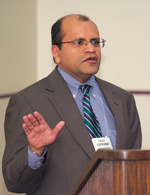Using e-mail in practice is e-asy, but exercise care
E-mail can improve communication with patients##mdash;it's even reimbursable##mdash;but it's effective only if it's used properly. One physician discusses the do's and some very important don'ts.
E-mail has the speed of a bullet, the power of a locomotive and the half-life of plastic, quipped John R. Maese, FACP, during an Internal Medicine 2010 session on using e-mail in practice.
“Choose your words carefully,” said Dr. Maese, a practicing internist in Staten Island, N.Y. “You can't take back what you wrote, and an e-mail lives forever.”

In addition to improving communication with colleagues, physicians stand to boost patient satisfaction by implementing e-mail into their practices. A 2009 Deloitte Health Survey found 57% of patients want secure, online access to their physicians, Dr. Maese said.
While some clinicians may fear a deluge of messages from patients should they start using e-mail, this hasn't happened at Kaiser Permanente, which has reported that 40% of its Medicare patients use an online portal. These patients send fewer than 2.1 messages a month, on average, and 51% send none at all, he said.
Best of all, some insurers will pay for e-mail consultations, Dr. Maese said.
When, and when not, to e-mail
Physicians who use e-mail in practice should decide from the start precisely how they intend to use it. It can be used, for example, to remind patients of appointments, communicate laboratory results and/or renew prescriptions, communicate with other physicians, and/or perform consultations, Dr. Maese said.
E-mail allows physicians to provide patients with a written record so they aren't phoning the office; this can lower phone costs and cut down on phone tag, Dr. Maese said. It also allows clinicians to give orders for home care, and to more completely instruct on matters like diet.
“It is really a good tool for chronic management, like asking patients, ‘Did you eat that doughnut today?’” Dr. Maese said.
A handy rule of thumb for deciding when to e-mail or not e-mail patients: If you can't say it in two or three lines, call the patient or have him or her come in for a visit
“You can't write, ‘Cancer. See ya,’” Dr. Maese said. “It shouldn't be used for bad, sensitive or complex information.”
E-mail also shouldn't be used for emergencies, or with new patients whose receptiveness to the medium is unknown, he added. As with a fax, every e-mail should include a disclaimer. Standard messages that are frequently sent to patients should be reviewed by an attorney before they become a regular part of the practice, he said.
Clinicians also need to decide who in the office will be allowed to read the e-mails, what the response time will be, and how e-mails are handled during vacations, holidays, weekends and at night, he added.
Once these issues have been clarified, the office manual should be rewritten (or written, as the case may be) to reflect the policy. Staff and patients should be apprised, as well.
“The patient needs to consent to the use of e-mail, and to know who in the office can read the e-mails,” Dr. Maese said. “E-mails also need to be retained as part of the medical record. ... Someone in the office needs to take ownership of the e-mail process.”
Keep language simple when e-mailing, he added. Thirty-six percent of patients in the U.S. have basic or below-basic health literacy, and the average adult reads at an eighth-grade level. “Try to e-mail at a sixth-grade level,” Dr. Maese said. “And if a patient misinterprets a message from you, correct it immediately.”
Staying secure
In nearly every context, e-mail is considered a written correspondence, which can have legal implications for you and your practice. It can, for example, make you vulnerable for committing a breach, such as an impermissible disclosure of personal health information, which is a violation of HIPAA. A breach is subject to significant financial penalties, even if one is unaware of the breach, Dr. Maese said.
As such, it's important to make sure your office e-mail system is secure, he said. When it is, all messages will be encrypted so that they can only be read by the intended user. Unencrypted e-mail, on the other hand, can be interrupted, altered and read by others.
Patients will initially need instructions to set up encrypted e-mail capability. Once they are registered, they will need to type in their e-mail addresses and passwords whenever they receive messages from the office, he said. Password protocols should be easy for the patient to set up, and his or her user ID and password should be unique, specific and easy to remember, such an e-mail address or date of birth, Dr. Maese said.
If a physician's office sends a secure e-mail to a patient who has a Web-based account like Gmail or Hotmail, the message will remain secure as long as the patient uses the “reply” button. It will not be secure if he or she starts a new e-mail thread, however. In that case, the physician's office must put the patient's e-mail into an encrypted format before responding, Dr. Maese said.
Getting paid
E-mail can be a billable service if it is used as an online consultation tool. It must meet criteria for some insurers, including Cigna, Aetna and WellPoint. The CPT code is 99444, and reimbursements run about $30 to $60, depending on the insurer, Dr. Maese said.
The consultation must be documented like any visit, and is part of the patient's record. The code must not refer to a previous E&M service performed and reported by the physician within the previous seven days, or within a postoperative recovery period.
“A post-visit e-mail can't be billed as an online consultation, nor an after-visit phone call if a patient didn't understand something,” Dr. Maese said.
The code should be recorded only once, and encompass all of the communication related to that e-visit, including phone calls, radiology and lab tests, and prescription orders, he said.





